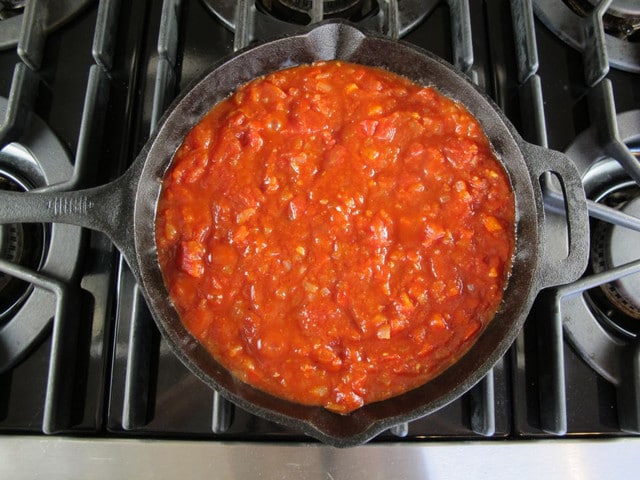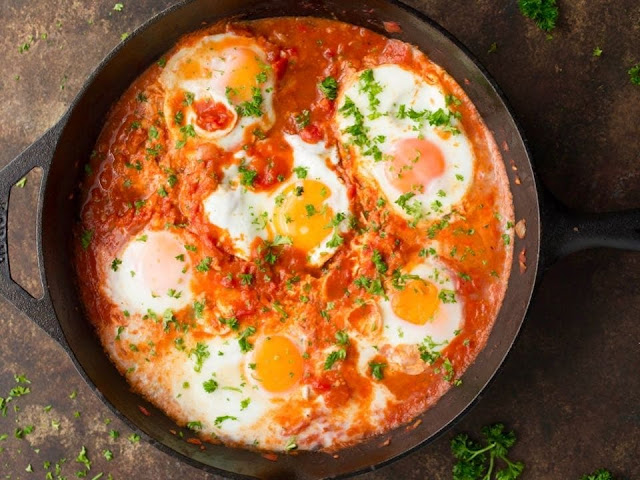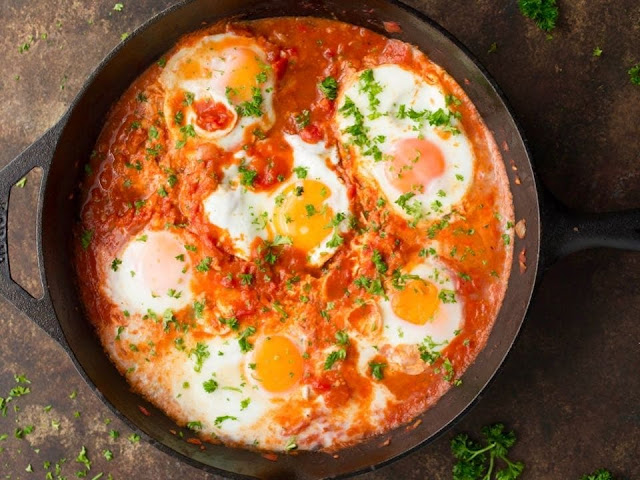If you are not familiar with shakshuka, I am excited to introduce the concept to you! The word shakshuka, rooted in Arabic means shaken together or mixed, which is the perfect way to describe this dynamic mixture of flavors and endless options for combinations. You’ll find variations of eggs shakshuka all over the Middle East in Palestine, Israel, Egypt and many other places. This easy and healthy egg dish is vegetarian, gluten free, and incredibly delicious.
The concept is very simple. A dish of eggs soft cooked atop a bed of thick reduced spicy tomato sauce with peppers. In the maghreb, this chunky sauce is known as matbucha. Similar preparations are made throughout the world, including a popular Italian dish known as “eggs in purgatory.” Shakshuka is somewhat different than the Italian dish; it’s generally spicier, and has the addition of peppers.
Shakshuka is also very popular in Israel, where it is often eaten for breakfast.
In Tel Aviv, the most famous place to eat shakshuka is a restaurant known as Dr. Shakshuka.
The charm of Dr. Shakshuka is evident from the moment you enter. The restaurant is housed in an aging building in the old port city of Jaffa. It’s buzzing all day long with local patrons as well as tourists, everybody eager to taste the “Tripolitanian”-style cooking. The owner Bino Gabso was born to a Libyan family that immigrated to Israel in 1949.
If you’re looking for variations on flavor, different ingredients can be added to the tomato base—jalapeños, green chilies, parsley, red pepper flakes, smoked paprika, additional vegetables or anything else that sounds tasty to you. I’ve even made it with a spinach/tomato base that turned out great. Use your imagination!
Shaksuka
1/2 onion, peeled and diced
1 clove garlic, minced
1 red bell pepper, seeded and chopped
4 cups ripe diced tomatoes, or 2 cans (14 oz. each) diced tomatoes
2 tablespoon tomato paste
1 teaspoon mild chili powder
1 teaspoon ground cumin
1 teaspoon paprika
Pinch of cayenne pepper, or more to taste (careful, it's spicy!)
Pinch of sugar (optional, to taste - omit for low carb)
kosher salt and pepper, to taste
6 large eggs
1/2 tablespoon fresh chopped parsley or cilantro (optional, for garnish)
1. Heat a deep, large skillet or sauté pan on medium. Slowly warm olive oil in the pan. Add chopped onion, sauté for a few minutes until the onion begins to soften. Add garlic and continue to sauté till mixture is fragrant.

2. Add the diced bell pepper, sauté for 5-7 minutes over medium until softened.

3. Add tomatoes and tomato paste to pan, stir until blended. Add spices and sugar, stir, and allow mixture to simmer over medium heat for 5-7 minutes until it starts to reduce.

4. At this point, you can taste the mixture and spice it according to your preferences. Add salt and pepper to taste, more sugar for a sweeter sauce, or more cayenne pepper for a spicier shakshuka (be careful with the cayenne... it is extremely spicy!
5. Crack the eggs, one at a time, directly over the tomato mixture, making sure to space them evenly over the sauce. I usually place 5 eggs around the outer edge and 1 in the center. The eggs will cook "over easy" style on top of the tomato sauce.

6. Cover the pan with a lid. Allow mixture to simmer for 10-15 minutes, or until the eggs are cooked and the sauce has slightly reduced. Keep an eye on the skillet to make sure that the sauce doesn't reduce too much, which can lead to burning.

7. Some people prefer their shakshuka with more runny yolks. If this is your preference, let the sauce reduce for a few minutes before cracking the eggs on top-- then, cover the pan and cook the eggs to taste, making sure the egg whites are set before serving. Garnish with the chopped parsley or cilantro, if desired. A sprinkle of feta cheese on top is also nice!


























